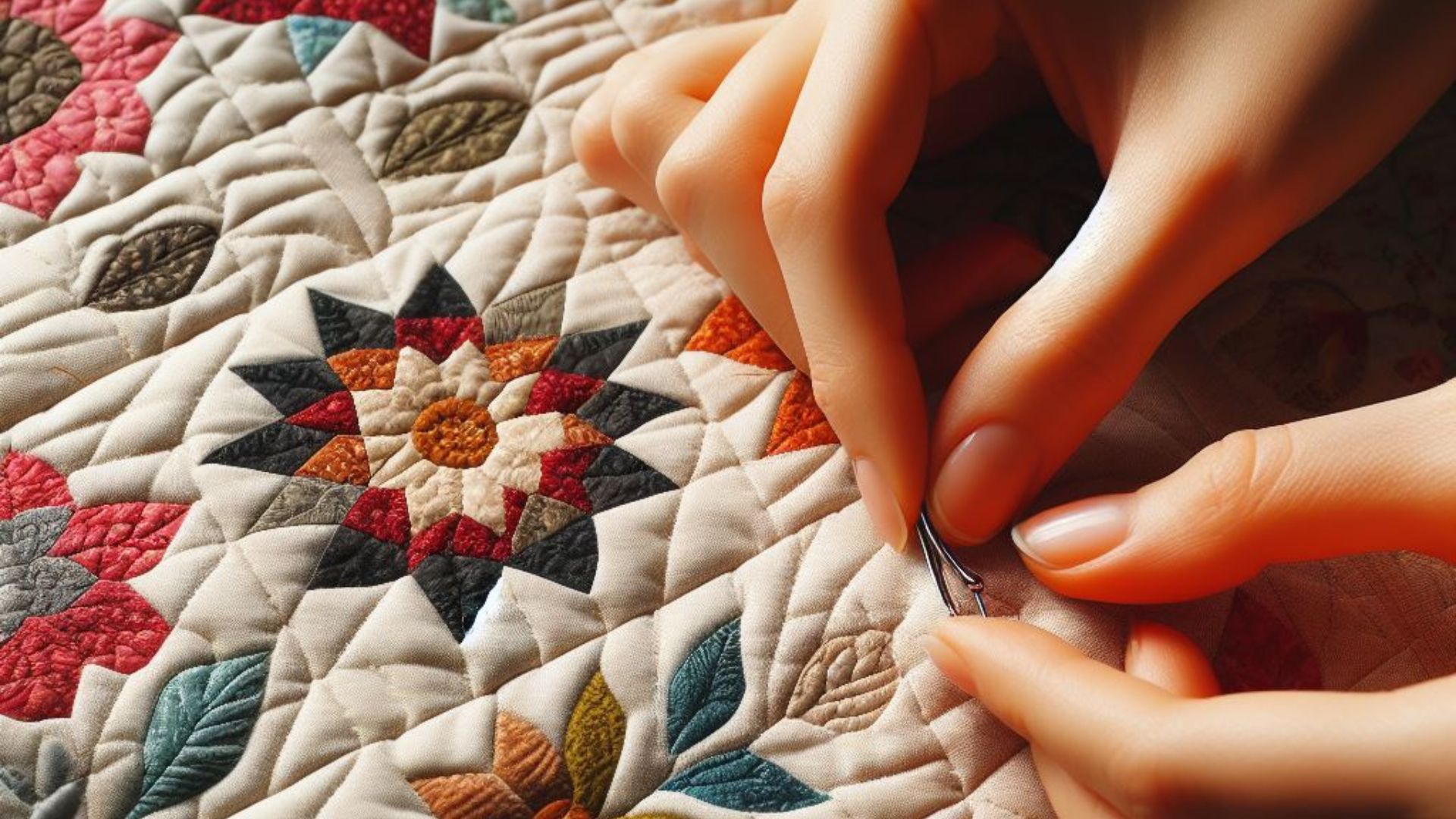Certainly. Quilting without a sewing machine is not only possible but can also be a rewarding and enjoyable experience. Whether you’re exploring a new hobby or simply want to create something beautiful with your hands, hand quilting offers a unique touch and allows you to craft a cozy, homemade quilt.
Let’s delve into the process of quilting by hand and explore the steps involved in this traditional craft.
Getting Started with Hand Quilting
Introduction to Hand Quilting
Hand quilting is a method where you sew together pieces of fabric by hand to create a quilt. It involves using a needle, thread, and thimble to stitch layers of fabric together.
Tools and Materials Needed
To start hand quilting, gather the following supplies:
- Fabric: Choose your preferred fabric for the quilt top, batting (middle layer), and backing.
- Needles: Specialized quilting needles designed for hand stitching.
- Thread: Select a strong, yet thin, thread suitable for quilting.
- Thimble: Protect your fingers and aid in pushing the needle through the layers.
- Quilting Hoop or Frame: Optional but can help keep the fabric taut while quilting.

Steps for Hand Quilting
Step 1: Prepare Your Quilt Sandwich
- Top Layer: Piece together your fabric squares or shapes to form the quilt top.
- Middle Layer: Place the batting underneath the quilt top layer.
- Backing: Lay the backing fabric right side down, followed by the quilt top and batting.
Step 2: Basting
Secure the layers together with safety pins or basting stitches to prevent shifting while quilting.
Step 3: Hand Quilting Techniques
- Start Small: Begin quilting in a small area to get comfortable with the process.
- Running Stitch: Commonly used in hand quilting, this simple stitch involves evenly spaced stitches through all layers of fabric.
- Rocking Motion: Practice a gentle rocking motion with the needle to make stitching smoother.
Step 4: Quilting Patterns
Choose from various quilting patterns like straight lines, curves, or intricate designs to complement your quilt’s style.
Step 5: Finishing Touches
Once the quilting is complete, trim any excess fabric and batting. Add binding around the edges to finish off your handmade quilt.
Tips for Successful Hand Quilting
- Relax and Take Breaks: Hand quilting requires patience and precision, so take breaks to prevent hand fatigue.
- Practice Consistency: Maintain even stitches for a polished look.
- Experiment with Thread and Needles: Find the combination that works best for you.
External Resources for Further Guidance
To enhance your hand quilting journey, here are three reliable external resources:
Moving forward
Quilting by hand may take more time and effort compared to using a machine, but the personal touch and satisfaction of creating something handmade are unparalleled. Give it a try, enjoy the process, and create a quilt that reflects your creativity and craftsmanship!
Remember, the beauty of quilting lies not just in the finished product but also in the joy of creating something unique with your own hands. Let’s dive deeper into the world of hand quilting and address some common questions that often arise for beginners and enthusiasts alike.
Frequently Asked Questions About Hand Quilting
1. Is hand quilting better than using a machine?
Hand quilting and machine quilting each have their merits. Hand quilting offers a personal touch and allows for more control over the stitching, while machine quilting can be faster and more efficient. It often boils down to personal preference and the desired outcome of the quilt.
2. How long does it take to hand quilt a project?
The time it takes to hand quilt a project varies based on factors like the size of the quilt, complexity of the design, your quilting speed, and level of experience. Larger and more intricate quilts can take weeks or even months to complete, while smaller projects may take less time.
3. What type of thread is best for hand quilting?
Choosing the right thread is crucial for hand quilting. Look for high-quality, sturdy threads specifically designed for quilting. Cotton threads are popular due to their strength and ability to glide smoothly through fabric layers.
4. Do I need a quilting hoop or frame for hand quilting?
Using a quilting hoop or frame is optional but can be beneficial. It helps keep the fabric taut and provides better control while stitching. Some quilters find it more comfortable to quilt with a hoop or frame, while others prefer quilting without one.
5. How can I improve my hand quilting stitches?
Practice is key to improving hand quilting stitches. Start with small projects to gain confidence and consistency in your stitching. Focus on maintaining even stitch lengths and tension throughout the quilt.
6. Can I mix hand quilting with machine quilting in the same project?
Absolutely! Mixing hand quilting with machine quilting, also known as “hybrid quilting,” is a creative way to add depth and texture to your quilt. For instance, you can hand quilt intricate designs on specific sections and use a machine for more uniform patterns or larger areas.
7. What are some essential tips for beginners in hand quilting?
- Start with simple patterns and smaller projects to build confidence.
- Use high-quality materials for better results.
- Take breaks to avoid hand fatigue and strain.
- Don’t be afraid to make mistakes; they’re part of the learning process.
Conclusion
Hand quilting is a timeless craft that allows for creativity, self-expression, and the joy of creating something handmade. Whether you’re a novice or an experienced quilter, the process of quilting by hand can be both relaxing and fulfilling.
Remember, there’s no right or wrong way to quilt. Experiment with techniques, find what works best for you, and enjoy the journey of transforming fabric into a cherished quilt.
With patience, practice, and a passion for quilting, you’ll create beautiful, one-of-a-kind quilts that hold not just warmth but also a piece of your heart.
Feel free to explore the provided external resources for more in-depth guidance on hand quilting techniques and tips. Enjoy your quilting adventure!
Comparison tabular
Let’s create a comparison table highlighting the key differences between hand quilting and machine quilting to help you better understand their distinct characteristics.
Hand Quilting vs. Machine Quilting: A Comparison
| Aspect | Hand Quilting | Machine Quilting |
|---|---|---|
| Process | Sewing together layers by hand using a needle | Sewing together layers using a sewing machine |
| Control | Provides more control over stitches and designs | Faster and more consistent stitching |
| Speed | Slower process due to manual stitching | Faster, efficient, and time-saving |
| Skill Level | Requires patience and practice for consistency | Easier for beginners, but skill improves with practice |
| Personal Touch | Adds a personal, handmade touch to the quilt | Uniform and precise stitches |
| Versatility | Allows for intricate and detailed designs | Suitable for larger projects and repetitive patterns |
| Equipment Needed | Basic tools like needles, thread, and thimble | Sewing machine and specific quilting accessories |
| Portability | Portable and can be done anywhere | Requires a stationary sewing machine |
| Learning Curve | Steeper learning curve for even stitches | Quick to learn but may need practice for expertise |
| Customization | Offers more freedom for unique designs | Limited by machine settings and patterns |
| Time Investment | Takes longer, especially for complex designs | Quicker completion, especially for larger quilts |
Which Method to Choose?
- Hand Quilting: Ideal for those who enjoy a personal touch, intricate designs, and the process of handcrafting. It requires patience and dedication but offers a unique, handmade feel.
- Machine Quilting: Suitable for those seeking efficiency, quicker results, and ease of use. It’s great for larger projects and repetitive patterns but might lack the personalized touch of hand quilting.
Consider your preferences, project requirements, and available time when choosing between hand quilting and machine quilting. Both methods offer distinct advantages, so feel free to explore and experiment with both to find what suits your style best!
This comparison table aims to provide a clear overview of the differences between hand quilting and machine quilting, allowing you to make an informed decision based on your preferences and project goals.
Wrapping up
Hand Quilting embodies tradition, patience, and the joy of crafting with your own hands. It’s a timeless art that connects us to generations past and allows for intricate, personalized designs that carry stories and emotions within every stitch.
Machine Quilting offers efficiency, speed, and the ability to tackle larger projects with ease. It’s perfect for those who seek quicker results and uniform stitching while still having the opportunity to unleash their creativity through various machine quilting techniques.
The Choice Is Yours
Ultimately, the choice between hand quilting and machine quilting depends on your preferences, the time you wish to invest, and the desired outcome of your quilt. There’s no right or wrong way to quilt—both methods have their own charm and advantages.
So, whether you’re gathered around a quilting frame, needle in hand, or sitting at a sewing machine with a plethora of colorful threads, embrace the journey. Let your imagination soar, experiment with techniques, and enjoy the process of transforming fabric into a work of art.
Whether you find joy in the slow, deliberate stitches of hand quilting or the precision and speed of machine quilting, let your quilts tell stories, warm hearts, and bring comfort for generations to come.
Happy quilting, and may your quilts be stitched with love, creativity, and a touch of your unique style!

For over a decade, I’ve been Mike, an artist, crafter, and designer deeply immersed in the Croc world. I thrive on crafting unique, size-inclusive patterns, fostering creativity, and sharing them on ktforum.com. My designs aim to ignite your creative spark and delight you, ensuring clarity and ease of use through rigorous testing. Join me in expressing your creative flair and showcasing your craft with joy.
Related Posts
- Can you quilt by hand instead of using a machine
Absolutely, quilting by hand is a timeless and rewarding craft that allows you to create…
- Quilting Without a Quilting Hoop: Tips and Techniques
Quilting is a beautiful craft that allows you to create stunning and cozy pieces. While…
- Quilting Without Templates: A Guide to Free-Form Quilting
Quilting is a delightful craft that allows you to weave together fabric, creativity, and skill…
- Creating a Quilt: A Timeless Craft
Quilting, a cherished craft passed down through generations, invites both beginners and seasoned artisans into…

